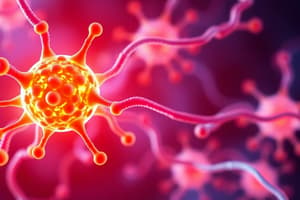Podcast
Questions and Answers
What role does cyclic AMP (cAMP) play in the signaling pathway initiated by glucagon?
What role does cyclic AMP (cAMP) play in the signaling pathway initiated by glucagon?
- It serves as a second messenger that transmits the signal internally. (correct)
- It functions exclusively outside the cell.
- It acts as a first messenger to initiate the cascade.
- It directly activates glucagon receptors.
Which component of the cyclic-AMP cascade directly converts ATP into cyclic AMP?
Which component of the cyclic-AMP cascade directly converts ATP into cyclic AMP?
- Glucagon Receptor
- Glucagon
- Protein Kinase A
- Adenylyl cyclase (correct)
In the context of hormone signaling, what is the primary function of a second messenger like cAMP?
In the context of hormone signaling, what is the primary function of a second messenger like cAMP?
- To directly catalyze metabolic reactions.
- To bind to hormone receptors on the cell surface.
- To transport hormones across the cytoplasmic membrane.
- To amplify the signal initiated by the first messenger. (correct)
How does glucagon lead to an elevation of intracellular cAMP levels when blood glucose is low?
How does glucagon lead to an elevation of intracellular cAMP levels when blood glucose is low?
What is the primary role of Protein Kinase A in the context of the cyclic-AMP signaling cascade?
What is the primary role of Protein Kinase A in the context of the cyclic-AMP signaling cascade?
What role does cyclic AMP play in the signal transduction process mediated by GPCRs?
What role does cyclic AMP play in the signal transduction process mediated by GPCRs?
Which of the following correctly describes the phosphoinositide signaling pathway?
Which of the following correctly describes the phosphoinositide signaling pathway?
How does hormonal regulation influence signal transduction through GPCRs?
How does hormonal regulation influence signal transduction through GPCRs?
What is a key feature of receptor amplification in GPCR signaling?
What is a key feature of receptor amplification in GPCR signaling?
Which statement correctly describes the role of second messengers in GPCR signaling?
Which statement correctly describes the role of second messengers in GPCR signaling?
Which of the following is NOT a characteristic of G protein-coupled receptors?
Which of the following is NOT a characteristic of G protein-coupled receptors?
What is the primary function of G proteins in GPCR-mediated signal transduction?
What is the primary function of G proteins in GPCR-mediated signal transduction?
In the context of the cyclic AMP signal pathway, which kinase is primarily activated as a result of increased cyclic AMP levels?
In the context of the cyclic AMP signal pathway, which kinase is primarily activated as a result of increased cyclic AMP levels?
What triggers the activation of the α subunit of a G protein in GPCR signaling?
What triggers the activation of the α subunit of a G protein in GPCR signaling?
Which molecule is produced by adenylyl cyclase upon activation by the glucagon receptor?
Which molecule is produced by adenylyl cyclase upon activation by the glucagon receptor?
In the phosphoinositide signaling pathway, which of the following is produced after the activation of phospholipase C?
In the phosphoinositide signaling pathway, which of the following is produced after the activation of phospholipase C?
How does GPCR signaling achieve signal amplification?
How does GPCR signaling achieve signal amplification?
What is the ultimate cellular role of cyclic AMP in GPCR signaling?
What is the ultimate cellular role of cyclic AMP in GPCR signaling?
Which of the following represents a key difference between the cyclic AMP and phosphoinositide signaling pathways?
Which of the following represents a key difference between the cyclic AMP and phosphoinositide signaling pathways?
What is the function of glucagon in hormonal regulation of glucose levels?
What is the function of glucagon in hormonal regulation of glucose levels?
After activation, what happens to the α subunit of the G protein when it hydrolyzes GTP?
After activation, what happens to the α subunit of the G protein when it hydrolyzes GTP?
Flashcards are hidden until you start studying
Study Notes
Signal Transduction
- Signal transduction: Process of converting signals from outside the cell to inside the cell to trigger a response
- Ligand: a molecule that binds to a receptor
- Receptor: A protein that binds to a ligand and initiates a signal transduction pathway
- Response: A change in cellular activity triggered by a signal transduction pathway.
G Protein-Coupled Receptors (GPCRs)
- GPCRs: Membrane receptors with seven transmembrane helices.
- Ligand binding site: Located on the extracellular side
- G protein binding site: Located on the intracellular side.
Cyclic AMP Cascade
- Glucagon: A hormone released when blood glucose is low.
- Glucagon receptor: A GPCR that binds glucagon.
- Adenylyl cyclase: An enzyme that converts ATP to cyclic AMP (cAMP).
- Cyclic AMP (cAMP): A second messenger that activates protein kinase A.
- Protein kinase A: An enzyme that phosphorylates proteins, leading to a cellular response.
Deactivation of GPCRs
- GTP hydrolysis: The α subunit of the G protein hydrolyses GTP to GDP, returning the G protein to its inactive state.
- Receptor inactivation: The receptor can be internalized in the cell, further reducing signaling.
Signal Amplification
- Each activated receptor can activate multiple G proteins.
- Each activated G protein can activate multiple adenylyl cyclase molecules.
- Each adenylyl cyclase molecule can generate multiple cAMP molecules.
GPCR Effector Molecules
- cAMP pathway: A major signal transduction pathway that uses cAMP as a second messenger.
- Phosphoinositide pathway: A signal transduction pathway that uses phosphoinositides as second messengers.
Studying That Suits You
Use AI to generate personalized quizzes and flashcards to suit your learning preferences.



